In the competitive world of compact SUVs, the Hyundai Kona and SsangYong Korando emerge as noteworthy contenders, each boasting unique characteristics and technological advancements. This article delves into the technical aspects and innovations that set these two models apart, helping potential buyers make an informed decision.
Hyundai Kona vs SsangYong Korando – Performance, range & efficiency compared
Powertrain Options: A Comparative Analysis
The Hyundai Kona offers an impressive array of powertrains, including petrol, full hybrid, and electric options. With horsepower ranging from 100 to an exhilarating 218, the Kona caters to a diverse audience. Its engine types include a 1.0L, 1.6L, and a robust 2.0L variant, with torque figures peaking at 265 Nm. This wide range of choices allows customers to select a configuration that suits their driving style and environmental considerations.
On the other hand, the SsangYong Korando presents itself with petrol and electric powertrains. The Korando’s petrol engine produces up to 190 horsepower, and it generates a respectable torque of 280 Nm. While it lacks the hybrid option found in the Kona, the Korando does offer a more streamlined powertrain that's easy to manage and maintain.
Fuel Efficiency and Economy
When it comes to fuel consumption, the Hyundai Kona outshines its counterpart with a remarkably efficient fuel economy rating of between 4.5 to 6.7 L/100km for its petrol variants. The electric version boasts a consumption of 14.6 to 16.8 kWh/100km, with an electric range of up to 514 km, making it an attractive option for eco-conscious drivers.
The Korando, however, registers higher fuel consumption figures, ranging from 7.5 L/100km for its petrol engines to 8.6 L/100km. Its electric range is capped at 339 km, which may be a consideration for those who frequently embark on longer drives.
Performance and Handling
In terms of performance, the Hyundai Kona excels with acceleration figures that send chills down your spine. The Kona can achieve 0-100 km/h in as little as 7.8 seconds, a testament to its sporty dynamics. The Kona’s top speed peaks at 208 km/h, promising an exhilarating driving experience.
Conversely, the SsangYong Korando also exhibits solid performance with a respectable 0-100 km/h acceleration time of around 8.4 seconds. Its maximum speed reaches 191 km/h, ensuring that it holds its own in spirited driving situations. However, it lacks some of the thrilling acceleration and top speeds that the Kona delivers.
Interior Comfort and Space
When it comes to cabin space, the SsangYong Korando takes the lead. With a trunk capacity of 551 liters, it offers more cargo space than the Kona's 466 liters, making it a suitable choice for families and those who require ample storage. The Korando also features a spacious interior, allowing comfortable seating for five passengers over extended journeys.
While the Kona provides a stylish and tech-savvy interior with innovative features like a digital cockpit and advanced infotainment system, it occasionally sacrifices some versatility in space for design aesthetics.
Safety and Technological Innovations
In the realm of safety, both models come equipped with an arsenal of features designed to protect occupants. The Hyundai Kona shines with its comprehensive suite of advanced safety technologies, including forward collision warning, lane-keeping assist, and a high safety rating in various crash tests.
The SsangYong Korando is also equipped with numerous safety features, although it may not encompass the extensive array found in the Kona. Innovations such as adaptive cruise control and automatic emergency braking are present, providing a secure driving experience.
Conclusion: Choosing Your Ideal Match
In conclusion, the choice between the Hyundai Kona and SsangYong Korando largely depends on individual priorities. The Kona exemplifies modern automotive engineering, showcasing versatility, performance, and innovative technologies, making it an excellent choice for those seeking sporty dynamics and efficiency.
On the other hand, the Korando stands out with its spacious interior and ample cargo capacity, appealing to buyers who require practicality in their everyday driving while sacrificing some fuel efficiency. Ultimately, test-driving both models will give you the best insight into which SUV aligns with your lifestyle and values.
Here’s where it gets real: The technical differences in detail
Costs and Efficiency:
Price and efficiency are key factors when choosing a car – and this is often where the real differences emerge.
Hyundai Kona has a to a small extent advantage in terms of price – it starts at 23100 £, while the SsangYong Korando costs 27000 £. That’s a price difference of around 3934 £.
Fuel consumption also shows a difference: Hyundai Kona manages with 4.60 L and is therefore convincingly more efficient than the SsangYong Korando with 7.50 L. The difference is about 2.90 L per 100 km.
In terms of energy consumption, the advantage goes to the Hyundai Kona: with 14.60 kWh per 100 km, it’s slightly more efficient than the SsangYong Korando with 16.80 kWh. That’s a difference of about 2.20 kWh.
As for range, the Hyundai Kona performs noticeable better – achieving up to 514 km, about 175 km more than the SsangYong Korando.
Engine and Performance:
Power, torque and acceleration are the classic benchmarks for car enthusiasts – and here, some clear differences start to show.
When it comes to engine power, the Hyundai Kona has a a bit edge – offering 218 HP compared to 190 HP. That’s roughly 28 HP more horsepower.
In acceleration from 0 to 100 km/h, the Hyundai Kona is slight quicker – completing the sprint in 7.80 s, while the SsangYong Korando takes 8.40 s. That’s about 0.60 s faster.
In terms of top speed, the Hyundai Kona performs hardly perceptible better – reaching 210 km/h, while the SsangYong Korando tops out at 191 km/h. The difference is around 19 km/h.
There’s also a difference in torque: SsangYong Korando pulls distinct stronger with 360 Nm compared to 265 Nm. That’s about 95 Nm difference.
Space and Everyday Use:
Beyond pure performance, interior space and usability matter most in daily life. This is where you see which car is more practical and versatile.
Both vehicles offer seating for 5 people.
In curb weight, Hyundai Kona is to a small extent lighter – 1370 kg compared to 1517 kg. The difference is around 147 kg.
In terms of boot space, the SsangYong Korando offers slightly more room – 551 L compared to 466 L. That’s a difference of about 85 L.
In maximum load capacity, the Hyundai Kona performs barely noticeable better – up to 1300 L, which is about 52 L more than the SsangYong Korando.
When it comes to payload, Hyundai Kona hardly perceptible takes the win – 490 kg compared to 463 kg. That’s a difference of about 27 kg.
Who comes out on top?
Overall, the Hyundai Kona shows itself to be leaves the rival little chance and secures the title of DriveDuel Champion.
It convinces with the more balanced overall package and proves to be the more versatile choice for everyday use.
Costs and Consumption
View detailed analysis
Engine and Performance
View detailed analysis
Dimensions and Body
View detailed analysis
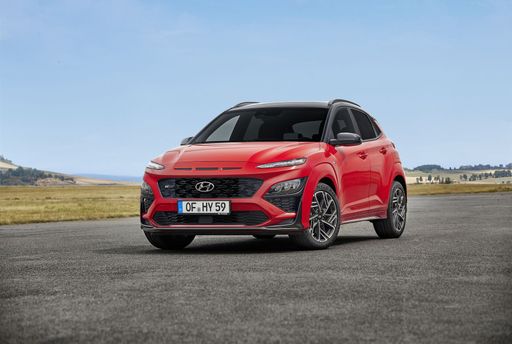 @ Hyundai Motor Company
@ Hyundai Motor Company
Hyundai Kona
Hyundai Kona
The Hyundai Kona wears its personality on the outside with bold styling and sprightly handling that turns city driving into something a little more fun than a commute. It blends practical space, modern tech and sensible running costs into a compact, stylish package — a smart pick if you want flair without paying luxury prices.
details @ Hyundai Motor Company
@ Hyundai Motor Company
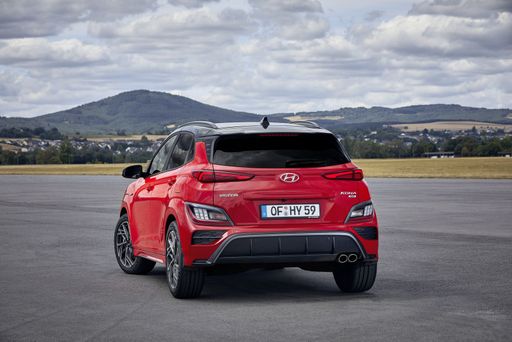 @ Hyundai Motor Company
@ Hyundai Motor Company
 @ Hyundai Motor Company
@ Hyundai Motor Company
 @ Hyundai Motor Company
@ Hyundai Motor Company
SsangYong Korando
The SsangYong Korando pairs bold, modern styling with a surprisingly roomy and practical cabin, so it looks confident at the lights and handles the daily grind without fuss. It swaps flashy badges for honest value, offering a composed ride, useful equipment and wallet-friendly running that make it an appealing pick for buyers who'd rather spend on weekends than on extravagant finance packages.
details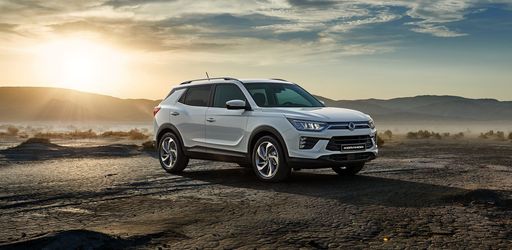 @ SsangYong Motor / KG Mobility
@ SsangYong Motor / KG Mobility
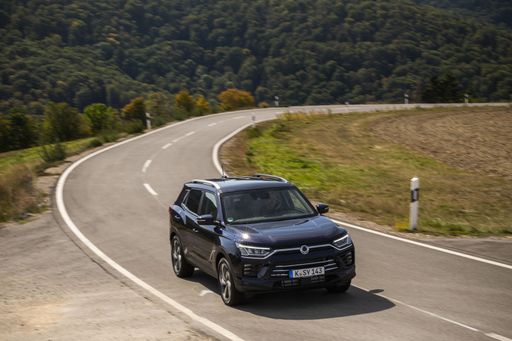 @ SsangYong Motor / KG Mobility
@ SsangYong Motor / KG Mobility
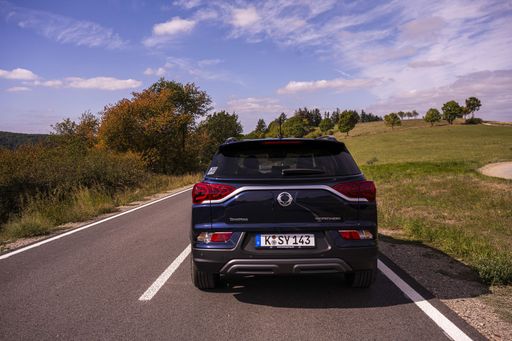 @ SsangYong Motor / KG Mobility
@ SsangYong Motor / KG Mobility
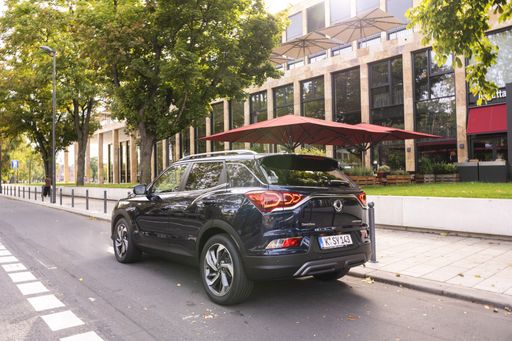 @ SsangYong Motor / KG Mobility
@ SsangYong Motor / KG Mobility
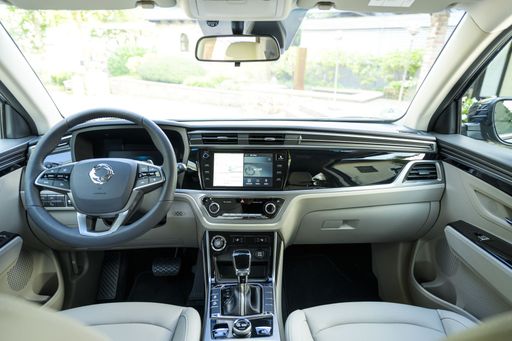 @ SsangYong Motor / KG Mobility
@ SsangYong Motor / KG Mobility
 @ Hyundai Motor Company
@ Hyundai Motor Company
|
 @ SsangYong Motor / KG Mobility
@ SsangYong Motor / KG Mobility
|
|
|
|
Costs and Consumption |
|
|---|---|
|
Price
23100 - 41600 £
|
Price
27000 - 42000 £
|
|
Consumption L/100km
4.6 - 7 L
|
Consumption L/100km
7.5 - 8.6 L
|
|
Consumption kWh/100km
14.6 - 16.8 kWh
|
Consumption kWh/100km
16.80 kWh
|
|
Electric Range
377 - 514 km
|
Electric Range
339 km
|
|
Battery Capacity
1.3 - 65.4 kWh
|
Battery Capacity
-
|
|
co2
0 - 163 g/km
|
co2
0 - 197 g/km
|
|
Fuel tank capacity
38 - 47 L
|
Fuel tank capacity
50 L
|
Dimensions and Body |
|
|---|---|
|
Body Type
SUV
|
Body Type
SUV
|
|
Seats
5
|
Seats
5
|
|
Doors
5
|
Doors
5
|
|
Curb weight
1370 - 1773 kg
|
Curb weight
1517 - 1840 kg
|
|
Trunk capacity
466 L
|
Trunk capacity
551 L
|
|
Length
4350 - 4385 mm
|
Length
4450 - 4465 mm
|
|
Width
1825 mm
|
Width
1870 mm
|
|
Height
1580 - 1585 mm
|
Height
1620 - 1645 mm
|
|
Max trunk capacity
1300 L
|
Max trunk capacity
1248 L
|
|
Payload
420 - 490 kg
|
Payload
410 - 463 kg
|
Engine and Performance |
|
|---|---|
|
Engine Type
Electric, Petrol, Full Hybrid
|
Engine Type
Petrol, Electric
|
|
Transmission
Automatic, Manuel
|
Transmission
Manuel, Automatic
|
|
Transmission Detail
Reduction Gearbox, Manual Gearbox, Dual-Clutch Automatic
|
Transmission Detail
Manual Gearbox, Automatic Gearbox, Reduction Gearbox
|
|
Drive Type
Front-Wheel Drive, All-Wheel Drive
|
Drive Type
Front-Wheel Drive, All-Wheel Drive
|
|
Power HP
115 - 218 HP
|
Power HP
163 - 190 HP
|
|
Acceleration 0-100km/h
7.8 - 11.9 s
|
Acceleration 0-100km/h
8.40 s
|
|
Max Speed
162 - 210 km/h
|
Max Speed
156 - 191 km/h
|
|
Torque
200 - 265 Nm
|
Torque
260 - 360 Nm
|
|
Number of Cylinders
3 - 4
|
Number of Cylinders
4
|
|
Power kW
85 - 160 kW
|
Power kW
120 - 140 kW
|
|
Engine capacity
998 - 1598 cm3
|
Engine capacity
1497 cm3
|
General |
|
|---|---|
|
Model Year
2024 - 2025
|
Model Year
2021 - 2023
|
|
CO2 Efficiency Class
A, D, C, E, F
|
CO2 Efficiency Class
F, G, A
|
|
Brand
Hyundai
|
Brand
SsangYong
|
Is the Hyundai Kona offered with different drivetrains?
Available configurations include Front-Wheel Drive or All-Wheel Drive.
The prices and data displayed are estimates based on German list prices and may vary by country. This information is not legally binding.
